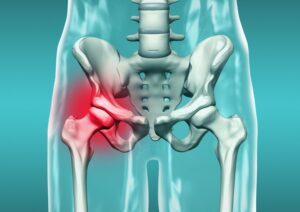It is a condition in which the head of the thigh bone (femur) comes completely out of the hip joint. It usually occurs due to congenital (congenital) or traumatic reasons. congenital hip dislocation, It occurs in babies as a result of the hip joint not developing properly at birth. Traumatic hip dislocation occurs after trauma such as a severe fall or traffic accident. Symptoms include pain in the hip, limitation of movement and leg length difference. Treatment requires the use of a cast or orthosis in the early stages and surgical intervention in advanced stages.
What are the Symptoms of Hip Dislocation?
 The most obvious symptom is severe pain, especially felt in the hip and groin area. This pain usually begins suddenly and increases with movement. hip dislocation People with this condition have difficulty moving their legs. When the hip joint is dislocated, movement limitation and difficulty are felt in the leg. The leg on the side where the dislocation occurs may appear shorter than the other. This may be especially evident in congenital hip dislocations. It makes it difficult for the person to walk. Symptoms such as limping or not being able to walk properly may occur while walking.
The most obvious symptom is severe pain, especially felt in the hip and groin area. This pain usually begins suddenly and increases with movement. hip dislocation People with this condition have difficulty moving their legs. When the hip joint is dislocated, movement limitation and difficulty are felt in the leg. The leg on the side where the dislocation occurs may appear shorter than the other. This may be especially evident in congenital hip dislocations. It makes it difficult for the person to walk. Symptoms such as limping or not being able to walk properly may occur while walking.
Swelling and bruising may occur around the joint. This condition is an indication of damage and inflammation in the joint. There may be a significant deformity in the hip. This is associated with disruption of the normal structure of the hip and the joint being placed in an abnormal position. After dislocation, spasms and contractions may occur in the muscles around the hip. This can increase pain and limitation of movement. hip dislocation symptoms It is important to consult an orthopedic specialist immediately when you experience Early diagnosis and treatment are critical to prevent complications caused by dislocation. Treatment is usually carried out with surgery and physical therapy.
What Causes Hip Dislocation?
Developmental hip dysplasia occurs at birth as a result of abnormal development of the hip joint in babies. Genetic factors and conditions the mother encounters during pregnancy (e.g. low amniotic fluid) may contribute to this condition. The most common cause in adults is trauma. It is especially caused by severe impacts such as traffic accidents, falling from a height or sports injuries. Some people may have naturally flexible joints. This condition causes the joints to move more than normal. It also makes one prone to dislocations. Joint diseases such as rheumatoid arthritis and osteoarthritis are caused by weakening the joint structure.
Diseases that affect the normal development of the hip joint, such as Perthes disease hip dislocation increases the risk. It is more common in individuals with muscle diseases or low muscle tone due to weakness of the muscles that support the joint. In children, conditions such as vitamin D deficiency negatively affect bone development and increase the risk. Hip dislocation symptoms These include pain, limitation of movement, difference in leg length and abnormal walking patterns. Treatment methods may vary depending on the cause and severity of the dislocation. Early diagnosis and treatment, especially in babies, is of great importance in preventing permanent damage. For adults, methods such as physical therapy and rehabilitation are applied.
What are the Treatment Methods for Hip Dislocation?
 Closed reduction is manual repositioning without requiring surgical intervention. This procedure, which is usually performed under anesthesia, is performed carefully by the doctor. After the procedure, the hip joint is stabilized and usually fixed with a cast or splint. If closed reduction fails or there is additional damage to the hip joint, open reduction may be required. In this procedure, the surgeon corrects the dislocation by surgically opening the hip joint.
Closed reduction is manual repositioning without requiring surgical intervention. This procedure, which is usually performed under anesthesia, is performed carefully by the doctor. After the procedure, the hip joint is stabilized and usually fixed with a cast or splint. If closed reduction fails or there is additional damage to the hip joint, open reduction may be required. In this procedure, the surgeon corrects the dislocation by surgically opening the hip joint.
If necessary, fixes the joint using internal fixation devices (screws, plates). Pelvic osteotomy, especially in children hip dislocation It is a method used in treatment. In this procedure, corrective incisions are made in the pelvic bones. The hip joint is allowed to return to its normal position. After osteotomy, the bones are fixed with plates and screws. Femoral osteotomy is the method used in patients with femur abnormalities. In this procedure, the femur bone is cut, brought into correct alignment and fixed with plates and screws. Rehabilitation after treatment is important to regain joint mobility.
Exercise prescribed by the specialist helps the patient return to normal activity. If there is irreversible damage to the hip joint or recurrent dislocations, surgery may be required. In this procedure, the damaged joint is removed and an artificial joint (prosthesis) is placed in its place. hip dislocation It is important to go for regular doctor check-ups after treatment. During these checks, the condition of the joint is evaluated and the treatment plan is rearranged if necessary. Treatment is individualized based on the patient's condition and response to treatment. With early diagnosis and appropriate treatment, the hip joint can return to normal functions.






